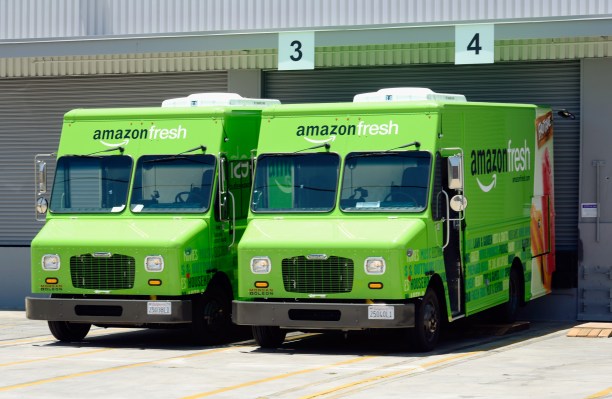Amazon Business, the retailer’s free program for business customers offering fast shipping, discounts and purchase approvals, is now expanding to include grocery delivery from AmazonFresh. That means businesses can stock their employee break rooms with fresh goods, like produce, plus groceries and other items from local stores.
The news was first announced in an email to Business customers on Wednesday, which was spotted by GeekWire. We’ve since confirmed this is a new addition to the Business program, though it’s essentially the same experience that’s available to consumer customers.
Like the consumer version of the AmazonFresh service, Amazon Business customers will need to have a Prime membership to take advantage of grocery delivery. Prime costs $99 per year, while AmazonFresh is sold as a $14.99 monthly subscription added on top of Prime.
Business customers can link their individual Prime accounts to their Amazon Business accounts, which will be required to place AmazonFresh orders.
AmazonFresh’s expansion to support Business customers could boost adoption for Amazon’s grocery delivery subscription offering — a service that operates in an increasingly competitive market, among others like Instacart, Shipt and more. Amazon said in July it had grown its Amazon Business user base to more than 1 million customers across the U.S., meaning businesses that had signed up for its service.
However, unlike the competition, AmazonFresh is not yet available across the U.S. Today, AmazonFresh serves Seattle, New York, Philadelphia, Stamford, Trenton, Boston, Baltimore, Washington, DC, Northern Virginia, Dallas, Chicago, Miami, Denver and seven regions across California (Los Angeles, Riverside, San Diego, San Francisco, Sacramento, San Jose and Stockton.) Outside the U.S., AmazonFresh is available in London, Berlin and Tokyo.
In addition to competitors like Instacart, Shipt and Peapod, Walmart has been moving quickly into the online grocery business, as well. Walmart now has more than 900 locations offering grocery pickup, a figure that’s up from 600 locations last year, and up from 100 stores just two years ago. It also just expanded its grocery delivery tests in partnership with Uber, and announced that it will work with Google to enable voice-based grocery orders starting next year.
Amazon, meanwhile, has been working to make its grocery delivery service more appealing, by dropping pricing last fall to the new rate of $14.99 per month, and, most recently, debuting “AmazonFresh Pickup” — drive-up grocery stores in Seattle where your orders can be loaded directly into your car. The company declined to share the number of AmazonFresh subscribers it has today.
Given Amazon’s massive acquisition of Whole Foods, the industry is now watching the retailer’s moves in grocery delivery more carefully, as it no longer seems that Amazon is treating AmazonFresh as an “experiment,” but is strategically moving into this vertical.
